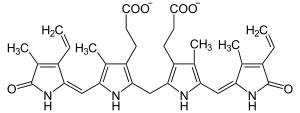Rotor syndrome
Rotor syndrome is a rare, relatively benign, autosomal recessive[2] bilirubin disorder. It is a distinct yet similar disorder to Dubin–Johnson syndrome[1] – both diseases cause an increase in conjugated bilirubin.
| Rotor syndrome | |
|---|---|
| Other names | Rotor type hyperbilirubinemia[1] |
 | |
| Bilirubin | |
| Specialty | Endocrinology |
Signs and symptoms
Rotor syndrome has many features in common with Dubin–Johnson syndrome, an exception being that the liver cells are not pigmented. The main symptom is a non-itching jaundice. There is a rise in bilirubin in the patient's serum, mainly of the conjugated type.
It can be differentiated from Dubin–Johnson syndrome in the following ways:[3]
| Rotor syndrome | Dubin–Johnson syndrome | |
| appearance of liver | normal histology and appearance | liver has black pigmentation |
| gallbladder visualization | gallbladder can be visualized by oral cholecystogram | gallbladder cannot be visualized |
| total urine coproporphyrin content | high with <70% being isomer 1 | normal with >80% being isomer 1 (normal urine contains more of isomer 3 than isomer 1) |
It has been suggested that Rotor syndrome may exacerbate toxic side effects of the medication irinotecan.[4]
Genetics

Rotor syndrome is inherited in an autosomal recessive manner.[2] The SLCO1B1 and SLCO1B3 genes are involved in Rotor syndrome.[5] Mutations in both genes are required for the condition to occur. The SLCO1B1 and SLCO1B3 genes provide instructions for making similar proteins, called organic anion transporting polypeptide 1B1 (OATP1B1) and organic anion transporting polypeptide 1B3 (OATP1B3), respectively. Both proteins are found in liver cells; they transport bilirubin and other compounds from the blood into the liver so that they can be cleared from the body. In the liver, bilirubin is dissolved in a digestive fluid called bile and then excreted from the body. The SLCO1B1 and SLCO1B3 gene mutations that cause Rotor syndrome lead to abnormally short, nonfunctional OATP1B1 and OATP1B3 proteins or an absence of these proteins. Without the function of either transport protein, bilirubin is less efficiently taken up by the liver and removed from the body. The buildup of this substance leads to jaundice in people with Rotor syndrome.[6]
Diagnosis
Increased conjugated hyperbilirubinemia is the hallmark for diagnosing Rotor syndrome. There is no distinct black pigmentation of the liver as seen in a similar, Dubin-Johnson Syndrome. Genes, SLCO1B1 and SLCO1B3 that result in complete functional deficiencies of both protein products (OATP1B1 and OATP1B3, respectively), are also present.
Treatment
To treat the jaundice, phenobarbital is normally used.
References
- Online Mendelian Inheritance in Man (OMIM) 237450
- Wolkoff AW, Wolpert E, Pascasio FN, Arias IM (February 1976). "Rotor's syndrome. A distinct inheritable pathophysiologic entity". The American Journal of Medicine. 60 (2): 173–179. doi:10.1016/0002-9343(76)90426-5. PMID 766621.
- Robert Wyllie; Jeffrey S. Hyams (2010-11-29). Pediatric Gastrointestinal and Liver Disease E-Book. Elsevier Health Sciences. pp. 186–. ISBN 978-1-4377-3566-6.
- Iusuf, D., Ludwig, M., Elbatsh, A., van Esch, A., van de Steeg, E., & Wagenaar, E. et al. (2013). OATP1A/1B Transporters Affect Irinotecan and SN-38 Pharmacokinetics and Carboxylesterase Expression in Knockout and Humanized Transgenic Mice. Molecular Cancer Therapeutics, 13(2), 492-503. https://dx.doi.org/10.1158/1535-7163.mct-13-0541\
- van de Steeg E, Stránecký V, Hartmannová H, Nosková L, Hřebíček M, Wagenaar E, van Esch A, de Waart DR, Oude Elferink RP, Kenworthy KE, Sticová E, al-Edreesi M, Knisely AS, Kmoch S, Jirsa M, Schinkel AH (2012). "Complete OATP1B1 and OATP1B3 deficiency causes human Rotor syndrome by interrupting conjugated bilirubin reuptake into the liver". The Journal of Clinical Investigation. 122 (2): 519–28. doi:10.1172/JCI59526. PMC 3266790. PMID 22232210.
- "Rotor Syndrome". NIH. U.S. Department of Health & Human Services.
- synd/2296 at Who Named It?
External links
| Classification | |
|---|---|
| External resources |
|
- Hyperbilirubinemia, Conjugated at eMedicine
- Rotor syndrome at NIH's Office of Rare Diseases
- Mentioned in MedlinePlus Encyclopedia Jaundice – yellow skin